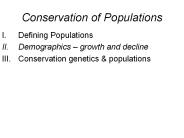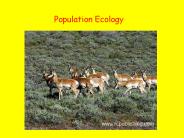Iteroparity PowerPoint PPT Presentations
All Time
Recommended
Annual strategy in plants and semelparous strategy in animals. Reproduce one time ... Pacific salmon semelparous (Altukhov et al. 2000) ...
| PowerPoint PPT presentation | free to view
Exceptions The most common form of exception to the simple predictions of the various approaches to finding life histories that produce an advantage to iteroparity is ...
| PowerPoint PPT presentation | free to download
Ch. 46-47 Reproduction and Development Sexual vs Asexual Reproduction Under what circumstances would each be an advantage? When would each be a disadvantage?
| PowerPoint PPT presentation | free to view
Changes in life history are caused by changes in the allocation of energy ... reproduce daily. dogshark -few large eggs -grow slowly, reproduce after 25 years ...
| PowerPoint PPT presentation | free to download
Title: Nerve activates contraction Author: Karl Miyajima Last modified by: Gabor takacs Created Date: 12/11/2000 1:39:32 AM Document presentation format
| PowerPoint PPT presentation | free to download
These species are high starvation tolerance, ... to cope with severe environmental conditions (e.g., salt marsh plants) ... Evolutionary mechanism of C-S ...
| PowerPoint PPT presentation | free to view
Chapter 52 Population Ecology Population Ecology Population ecology is the study of the populations and their interactions with the environment.
| PowerPoint PPT presentation | free to download
Exponential population growth is said to be happening Under these conditions, ... Cognitive Maps Migration Piloting, Orientation, ... Document presentation format:
| PowerPoint PPT presentation | free to view
Population density - # of individuals per unit area. ... The agave plant. 2Repeated reproductive episode - organism produces smaller numbers of offspring. ...
| PowerPoint PPT presentation | free to download
Population Ecology AP Chap 53
| PowerPoint PPT presentation | free to view
With selfing, expect reduced male allocation due to local mate competition ... Weevil attack. Fruit remaining. Seed Dispersal. Why disperse? Escape hypothesis ...
| PowerPoint PPT presentation | free to view
Estimating Viable Salmonid Population Parameters for Snake River Steelhead using Genetic Stock Identification of Adult Mixtures at Lower Granite Dam
| PowerPoint PPT presentation | free to download
Ecology oikos + ology study of home Ernst Haeckel Life History the end Newly hatched salmon fry the pay off Life History Semelparity Life History Breed once and ...
| PowerPoint PPT presentation | free to view
Conservation of Populations Defining Populations Demographics growth and decline Conservation genetics & populations I. Defining populations Spatial disjunction ...
| PowerPoint PPT presentation | free to download
Population Ecology
| PowerPoint PPT presentation | free to view
Population Ecology The Interaction of Limiting Factors Density-dependent and density-independent limiting factors often work together to regulate the size of a ...
| PowerPoint PPT presentation | free to view
Title: video Author: BCP User Last modified by: Thompson, Heather Created Date: 7/11/2002 5:04:39 PM Document presentation format: On-screen Show (4:3)
| PowerPoint PPT presentation | free to download
Population Ecology Chapter 52 Population Ecology Changes in population size (N) We can substitute r = (b - d) to give: N t = rN N1=1000 N2=1500 For example
| PowerPoint PPT presentation | free to view
Chapter 52 (pgs. 1151- 1172) Population Ecology AP minknow How density, dispersion, and demographics can describe a population. The differences between exponential ...
| PowerPoint PPT presentation | free to view
... survivorship curves. a. type I survivorship curve. b. type II survivorship ... c. type III survivorship curve. demography (cont.) 3. population growth models ...
| PowerPoint PPT presentation | free to view
Coniferous Forest. Grasslands. Prairie. Savanna. Chaparral. Steppes. Deserts. 300 Latitudes ... DN/Dt = B D. Zero population growth. Exponential population ...
| PowerPoint PPT presentation | free to download
Douglas R. Hatch, Ryan Branstetter, John Whiteaker, Shawn Narum, Jeff Stephenson ... Hardy-Weinberg equilibrium. Genotypic Linkage Disequilibrium ...
| PowerPoint PPT presentation | free to view
A. density - number of individuals per unit area ... (birth & death rates and emigration & immigration rates) that affect population ...
| PowerPoint PPT presentation | free to view
Population Ecology Chapter 52
| PowerPoint PPT presentation | free to download
- Demography: studies changes in population ... structure of a community are defined by its species composition and the interactions between the species. Plant ...
| PowerPoint PPT presentation | free to download
Animal Ecology Chapter 38 ...
| PowerPoint PPT presentation | free to download
96% of marine fish have pelagic eggs/larvae. Fecundity varies from few to millions/year ... egg # is a function of fish size independent of age ...
| PowerPoint PPT presentation | free to view
... is the study of how organisms (biotic) interact with each other and their environment (abiotic) ... Biotic Potential. Exponential growth model - J curve ...
| PowerPoint PPT presentation | free to view
... Demography: studies changes in population size. ... Community properties and structure are given by species composition and species ... plant defenses against ...
| PowerPoint PPT presentation | free to download
Introduction to Ecology Chapters 52 Limiting nutrient the nutrient that must be added to increase primary productivity Example: nitrogen or phosphorus are often ...
| PowerPoint PPT presentation | free to view
Life History Patterns Ch.10 Life history patterns = how they reproduce Maturity = age at first reproduction Parity = # of times an organism reproduces
| PowerPoint PPT presentation | free to download
Chapter 53 Population Ecology
| PowerPoint PPT presentation | free to view
Marine from the Bering Sea to the New Zealand. without any discontinuity, ... Air. Sea Surface Water. Data from Miyazaki, ORI, U. Tokyo. 2002/6/21. 7 ...
| PowerPoint PPT presentation | free to view
Unit 9: Ecology Chapters 50 55
| PowerPoint PPT presentation | free to view
... in a stream, note prominent fin margins. J. Rhodes. A. Dittman ... Note the spots on the dorsal fin, body, and tail, and short jaw. Rainbow/steelhead trout, ...
| PowerPoint PPT presentation | free to view
Chapter 52: Population Ecology Population Characteristics Population Dynamics Clumped Dispersion of Population Uniform Dispersion of Population Random Dispersion of ...
| PowerPoint PPT presentation | free to view
Single species groups where individuals have a high likelihood of interacting. ... if older individuals are more fecund, and if survival probability is high ...
| PowerPoint PPT presentation | free to view
Salmon Life History and Ecology. Generalized life history ... Semelparity Salmon reproduction. Sockeye males competing for a mate ...
| PowerPoint PPT presentation | free to view
A population is a group of individuals of a single species that simultaneously ... Figure 52.6 An example of semelparity: Agave (century plant) ...
| PowerPoint PPT presentation | free to view
Topic 17. Lecture 26. Evolution of Populations and Ecosystems-I Last time, we considered whatever little is understood regarding Macroevolution at the functional ...
| PowerPoint PPT presentation | free to download
Sensory perception. 1. Olfaction smell. nares - often a pit with a flap of skin. Olfactory rosette structure ... Leptocephali, elver, adults. Migrations: ...
| PowerPoint PPT presentation | free to view
... of larval development of swallowtail butterfly larvae at higher temperatures ... Such an interaction is evident in development of swallowtail larvae: ...
| PowerPoint PPT presentation | free to download
Population Ecology I Population structure and distribution; life-history trade-offs and reproductive strategies Opening photo, Unit 2. Cain et al. (p. 153)
| PowerPoint PPT presentation | free to view
Survivorship (lx): proportion of individuals that survive from birth to age x ... Nestling weight is smaller when clutch sizes are larger in Great tits ...
| PowerPoint PPT presentation | free to view
Some organisms produce many, usually smaller offspring, while ... Common toads lay all their eggs within about one week, so a male ... American jacana. Egg ...
| PowerPoint PPT presentation | free to view
BIOL 4120: Principles of Ecology Lecture 7: Life Histories and Evolutionary Fitness Dafeng Hui Office: Harned Hall 320 Phone: 963-5777 Email: dhui@tnstate.edu
| PowerPoint PPT presentation | free to download
Animal Ecology Chapter 38 Ecology Ecology investigates the interactions among organisms and between organisms and their environment. Hierarchy of Ecology Organism ...
| PowerPoint PPT presentation | free to download
Population Ecology Chapter 52 Chapter 52 Population Ecology Population ecology is the study of populations in relation to the environment Includes environmental ...
| PowerPoint PPT presentation | free to view
Charmane Ashbrook, Michael Mizell, & Ken Warheit Tomelleri ESA listing Sport selective fishery impacts? More reasons Variable survival estimates Use a control to ...
| PowerPoint PPT presentation | free to download
Silent Spring Ecology Project Chapter 52 By: Jacqueline Laurenzano , Judene Mavrikis, Samantha Viscovich, and Rebecca Wojfnis Density: A Dynamic Perspective A ...
| PowerPoint PPT presentation | free to download
Topic 17. Lecture 27. Evolution of Populations and Ecosystems-II What questions can be addressed by considering Macroevolution of simple phenotypes?
| PowerPoint PPT presentation | free to download
a population that can be assessed with a measurement or estimate ... Coconut palms and kiwis produce a few, big offspring with high survivorship probabilities ...
| PowerPoint PPT presentation | free to view
An animal's environment includes all of the conditions that affects survival and ... point will we surpass the carrying capacity for our planet? Logistic Growth ...
| PowerPoint PPT presentation | free to view
Population Ecology Human Populations No population can grow indefinitely and humans are no exception Figure 52.22 8000 B.C. 4000 B.C. 3000 B.C. 2000 B.C. 1000 B.C ...
| PowerPoint PPT presentation | free to download
Phenotypic plasticity 'flexibility' in life-history. Life history components ... Swallowtail caterpillars -compare 'performance' in either environment ...
| PowerPoint PPT presentation | free to view
Density number of individuals per area. Dispersion pattern of spacing ... Dungeness crab large adult males are harvested by humans, small juveniles are ...
| PowerPoint PPT presentation | free to view
























































